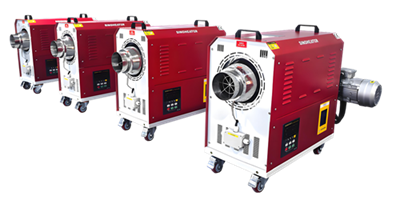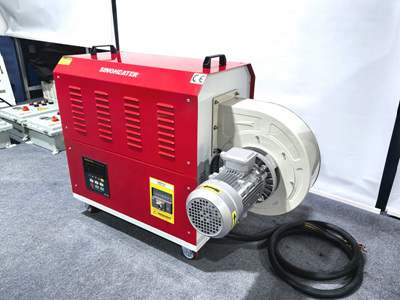In the surface treatment of plastic products, heating with a hot air blower is a crucial step, and its technique directly affects the processing quality and efficiency. The following is a summary of heating techniques based on equipment operation, process control and safety regulations:
First, equipment operation skills
Precise temperature control
Set range: Adjust the temperature according to the plastic material (for example, 80-100℃ for ABS plastic and 120-150℃ for PET film stretching) to avoid deformation caused by excessively high temperature or adhesion affected by excessively low temperature.
Real-time monitoring: The K-type thermocouple is used to provide real-time feedback on the outlet air temperature, and in combination with the temperature controller, the fluctuation is controlled within ±1℃.
Air volume and wind speed regulation
Uniform heating: Adjust the air volume through a frequency converter or air damper to ensure that the hot air evenly covers the surface of the product, avoiding local overheating or overcooling.
Distance optimization: Keep the outlet of the hot air blower 10-30cm away from the product (adjust according to the material) to ensure that the hot air is in full contact.
Heating time management
Stage control: During the preheating stage, rapidly increase the temperature to the target temperature; during the setting stage, maintain a constant temperature (for example, film stretching needs to last for 3 to 5 minutes).
Avoid overheating: Set the upper limit of heating time based on the thickness and material properties of the product (for thick-walled products, ≤10 minutes).
Second, process optimization techniques
Material compatibility
Thermoplastics: such as PP and PE require relatively low temperatures (80-120℃) to avoid melting. Engineering plastics (such as PC and POM) require higher temperatures (120-180℃).
Composite materials: Plastics containing glass fibers or additives need to be heated in a gradient to prevent local stress concentration.
Surface pretreatment
Cleaning: Before heating, remove oil stains with alcohol or a special cleaner to enhance the efficiency of hot air heating.
Pre-coating: For products that need to be coated, a primer can be sprayed first and then dried, followed by secondary curing through a hot air blower.
Post-processing collaboration
Cooling control: Slow cooling after heating (such as natural cooling or staged cooling) to reduce internal stress.
Secondary processing connection: Printing, hot stamping or bonding are carried out immediately after heating to ensure surface activity.
Third, safety and maintenance skills
Safety Operating Specifications
Fire and explosion prevention: Keep away from flammable materials, ensure good ventilation, and avoid direct hot air blowing on volatile solvents.
Protective measures: Operators should wear heat-resistant gloves and goggles to prevent scalding or splashing of foreign objects.
Equipment maintenance
Regular cleaning: Remove dust from the heater and air ducts to prevent a decline in thermal efficiency.
Component inspection: Inspect the heating wire, thermocouple and temperature controller monthly to ensure there is no aging or damage.
Emergency handling of faults
Abnormal temperature: Stop the machine immediately to check the temperature control system and heating elements.
Insufficient air volume: Inspect the fan, air damper and filter, and replace the clogged parts in time.
Fourth, examples of typical application scenarios
Plastic film stretching
Technique: The hot air blower heats evenly along the width of the film, and in combination with the speed of the stretching roller (such as 5-10m/min), it ensures that the molecular chain orientation is consistent.
Demolding of injection molded parts
Technique: Locally heat the mold (such as 80-90℃ for gear molds), and utilize thermal expansion to facilitate demolding of the product and reduce ejection marks.
Pipe expansion
Technique: The hot air blower rotates to heat the end of the pipe (150-180℃), and in combination with the flaring die, apply pressure slowly to avoid cracking.
Fifth, suggestions for efficiency improvement
Automation integration: Link the hot air blower with the PLC control system to achieve automatic adjustment of temperature, air volume and time.
Hot air circulation utilization: By using hot air circulation type equipment, the waste heat is recovered, filtered and reused, saving energy by more than 30%.
Multi-station design: In large-scale production lines, multiple hot air blowers are configured to heat different products in different zones, thereby enhancing production capacity.




